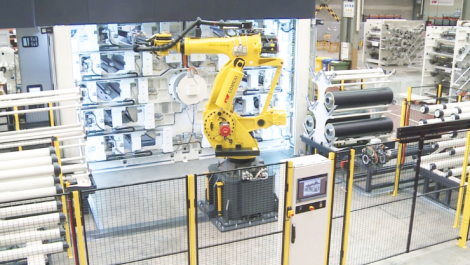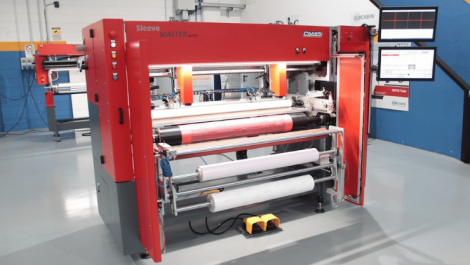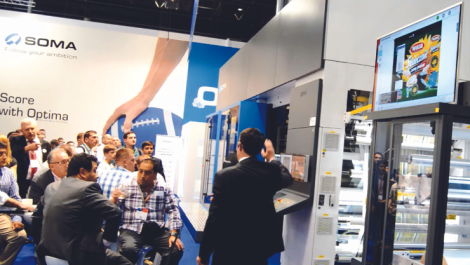Students taking part in the Phoenix Challenge were happy to receive The Essential Handbook for Flexography & Packaging Printing
Almost 2000 printers, converters, print buyers, pre-press providers, suppliers and other members of the global package printing community participated in the Flexographic Technical Association’s Forum and INFO*FLEX exhibition, held in March in Fort Worth, Texas. Michal Lodej was one of them.
‘Power of the Past, Force of the Future’ was the slogan for this year’s Forum, an event that delivers highly technical analysis of important areas in the flexo printing process, as well as trends in the industry, every year.
Before the Forum got underway, FTA president Mark Cisternino welcomed the attendees, ‘The Forum and INFO*FLEX brands have evolved into one cohesive, multi-dimensional event that seems to perfectly fit the educational, networking and business commerce needs within the FTA membership. Its continued growth and expansion of coverage mirror the incredible degree of market dynamics that are currently being experienced within the package printing and converting industry.’
Doing it FIRST
Chaired by Jennye Scott, Berry Plastics Corp, and Paul Teachout from Nilpeter, the Forum kicked off on the Sunday with the ‘Understanding the Customer FIRST’ session. FIRST is the FTA’s certification programme that aims to standardise practices within the flexo industry.
Representatives from two leading print buyers, General Mills and Snyder’s-Lance, took to the podium to share insights on print quality, brand management, and how to achieve a symbiotic relationship between the printer and the brand. They shared trends developing in North America, which mirror those developing in Europe.
On the topic of trends, Gail Wong, design logistics manager at General Mills, said, ‘The average number of items in a supermarket is 42,000. Visual cues, such as colour, shapes, numbers and words, help to stop customers in the aisles. Colour is critical to a brand’s identity and its perception. The packaging is the primary point of introduction with a consumer and a customer’s impression of that brand.
‘Beautiful imagery and consistent reproduction is key. One trend we are seeing now is more subtle colours being used in the backgrounds of images and in some instances removing spot colours and printing with an expanded colour gamut or just CMYK. In some cases, brands are removing the imagery completely and are showing the food itself with a window in the packaging.’
Ms Wong emphasised, ‘Super packaging requires super work throughout the entire supply chain. We have now taken steps to make sure colour management is standardised throughout every stage of production. This helps us to show our marketing department exactly what a product will look like. We have done this all by using FIRST methodology and when everything is measured then everyone becomes a lot happier as we can go to production quicker.’
Dawn Connell, marketing coordinator at Snyder’s-Lance, added her thoughts on the advantages of using FIRST standards. She said, ‘Snacks exist outside normal boundaries of meals and play a diverse role in people’s meals. So we look for different ways to market to our customers. Products are on billboards 365 days a year to catch the eyes of hungry customers where ever they are. Consumers react to consistency so we look for one thing, colour. If the colour is off the customer may miss that package and go for a competitor brand. Master proofs, charts and logs help maintain consistency and the work with repro and printers to help this.’
She added, ‘Marketers always have big demands, and if they can’t get their prints then they are not happy. Now companies engage with printers a lot more so that they have a better understanding of what can be achieved. This helps to make sure all suppliers are on the same hymn sheet. So the proof helps to communicate with brand managers.
‘Accurate fingerprints at each supplier are taken and then sent to pre-press so jobs are sent to press with the knowledge of how each press performs. There is no easy way to do this and it can take a long time, but you will see a change in tolerance. With a web-based process control you can help review accuracy in real time to provide change.’
Those in the audience were keen to know how much these large brands actually use flexo. Ms Wong answered, ‘Around 30% of materials we use are printed flexo. This is why we use FIRST more and more because for better print quality we need consistency in everything. We can’t afford the time or manpower to pull off jobs because they don’t meet the proof, so we have adopted your specifications where printers adhere to FIRST recommendations.’
On the table top
INFO*FLEX, whichoriginallystarted as a small gathering of tabletop displays, is now a tradeshow in its own right and it is growing larger and more expansive every year. This year a total of 236 companies occupied the stands across nine aisles of the Fort Worth Convention Center. Products on display spanned everything from colour management software, print inspection systems, multi-process printing presses, to proofers and prototypers, job management software and press components.
For the first time, the show floor also saw the addition of live demonstrations of running machinery as well as the Solutions Theater, which delivered a range of subject matter, from modern colour workflows to high speed inks, to flat top dots, to lamination and slitter/rewinder productivity.
Also at the exhibition was the Phoenix Challenge competition for schools, which sees students studying a range of different graphics arts qualifications, compete against each other in overall flexo knowledge. The initiative works brilliantly to ensure that those who graduate into a graphic arts career have a good understanding of the flexo industry.
Excellence awarded
Another arm of the event is the Excellence in Flexography Awards. A great many awards were given out, including the Technical Innovation Award which went to Flexomaid for its Aeromaid cleaning technology. ‘When we decided to move forward with this idea, we knew it had huge potential. This award confirms, once again, that our equipment and detergents really improve the efficiency of our customers’ operations. For us, that’s what matters most. We are extremely honoured by this prestigious award,’ said Éric Thibault, business development director.
A particular highlight was the 2016 President’s Award which went to the president of ATIF, Sante Conselvan, for his work leading the formation of the FTA Europe and vision of a stronger, unified European flexographic industry.
However, the biggest shock of the Awards Banquet came at the presentation of the next inductee to the FTA’s Hall of Fame, which for the first time in the organisation’s history, was awarded to a serving president, Mark Cisternino.
Those who wanted to view the winning entries of the competition, were able to do so at the red carpeted Awards Gallery during both days of INFO*FLEX.
If attendance at INFO*FLEX is anything to go by then the flexo industry is in a strong position in the US. The FTA’s commitment to certification and setting standards is helping drive the growth and improvement in quality across the board. This is backed up by excellent educational programmes in colleges which see graphic arts students receiving a thorough grounding in the understanding of print processes.






